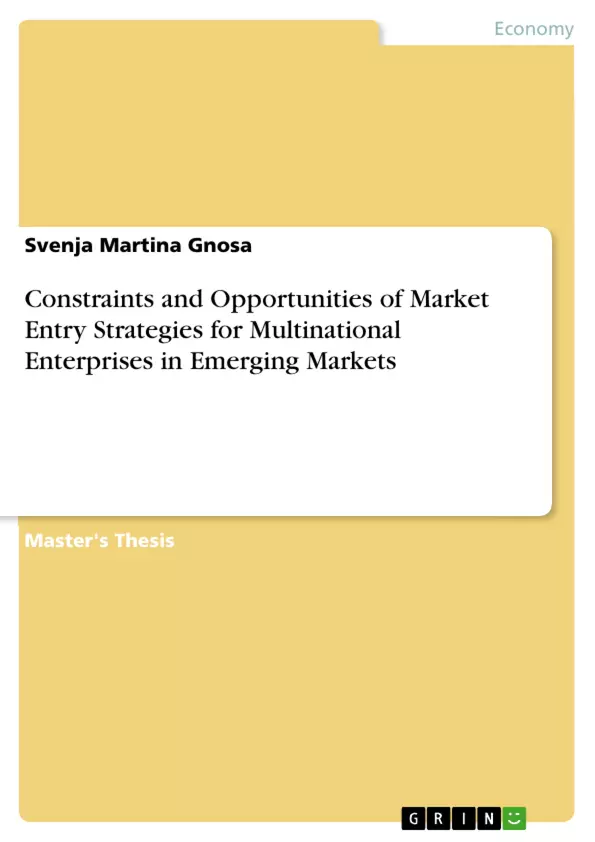During the last few decades, globalization has created an increasingly competitive landscape and with established markets becoming saturated, multinational enterprises (MNEs) have turned towards emerging markets in order to capitalise on new opportunities for economic growth (London and Hart 2004). Especially through the recent global crisis, the key role of developing and emerging countries, as they have sought to sustain global economic growth, has become the focal point of worldwide interest (Rao 2010).
According to McKinsey (2010), “an ongoing shift in global economic activity from developed to developing economies, accompanied by growth in the number of consumers in emerging markets, are the global developments that executives around the world view as the most important for business and the most positive for their own companies profits over the next five years.”
The results of recent surveys, such as those by the International Monetary Fund, predict that developing and emerging markets will grow by 6.3% in 2011 In turn this has evoked a significant sense of urgency among several MNE executives (Rao 2010).
Furthermore, a survey by McKinsey (2011) found that in the coming decade more then 45% of global GDP growth will be contributed by China, India, Russia, Indonesia, Turkey and Mexico. Likewise, in about 15 years time about 57% of the one billion households with an income > 20.000$ per annum will be in developing countries.
As Cavusgil et al (2002, p. 166) pointed out, “…once thought of as backward and low tech, these regions are now rapidly transforming their economies.” By adopting new production techniques and technologies, markets such as China, India and South Korea have become vital places for production. Many companies from traditional developed nations have capitalised on this trend, shifting their production and research and development (R&D) facilities, and strengthening their distribution and service networks in emerging markets. In so doing, foreign market activities have reached a new stage of development: beyond the BRIC-countries second-tier emerging markets are becoming an economic driving force, which means that companies must adapt their product and service strategies in an effort to develop sustainable success by not only reaching premium customers but also “Micro-Potentials”, the huge mass of customers with small budgets (KPMG 2011; Pacek and Thorniley 2007). [...]
Inhaltsverzeichnis (Table of Contents)
- INTRODUCTION
- 1. METHODOLOGY
- 2. DEFINITIONS
- 3. IMPORTANT CHARACTERISTICS AND CHALLENGES OF EMERGING MARKETS
- 4. ADVANTAGES AND DISADVANTAGES OF MARKET ENTRY MODES
- 4.1 Joint Venture
- 4.2 Greenfield
- 4.3 Acquisition
- 5. APPROACHES TO EVALUATE THE EFFICIENCY OF MARKET ENTRY MODES
- 6. CASE STUDIES
- 6.1 Wal-Mart company background and history
- 6.2 Wal-Mart's market entry failure in South Korea
- 6.3 Wal-Mart's success in India
- CONCLUSION
Zielsetzung und Themenschwerpunkte (Objectives and Key Themes)
This dissertation examines the constraints and opportunities of market entry strategies for multinational enterprises (MNEs) in emerging markets. It analyzes the challenges and advantages of different market entry modes, such as joint ventures, greenfield investments, and acquisitions. The dissertation uses case studies of Wal-Mart's experiences in South Korea and India to illustrate the complexities of market entry in emerging markets.
- The increasing importance of emerging markets for MNEs
- The challenges and opportunities of market entry in emerging markets
- The different market entry modes available to MNEs
- The factors that influence the success or failure of market entry strategies
- The role of case studies in understanding market entry strategies in emerging markets
Zusammenfassung der Kapitel (Chapter Summaries)
The introduction of the dissertation highlights the growing significance of emerging markets for MNEs as established markets become saturated. It emphasizes the recent global economic crisis and the importance of developing and emerging countries in sustaining global economic growth. The chapter provides a brief overview of the dissertation's focus and key themes.
Chapter 1 outlines the methodology used in the dissertation. It explains the research approach, data collection methods, and analytical techniques employed to examine the topic of market entry strategies in emerging markets.
Chapter 2 defines key terms and concepts relevant to the dissertation, such as multinational enterprises, emerging markets, market entry modes, and strategic alliances. It provides a conceptual framework for understanding the complexities of market entry in emerging markets.
Chapter 3 examines the important characteristics and challenges of emerging markets. It analyzes the unique features of these markets, including their rapid economic growth, diverse cultural contexts, and regulatory environments. The chapter explores the challenges faced by MNEs when entering emerging markets, such as political instability, corruption, and infrastructure constraints.
Chapter 4 delves into the advantages and disadvantages of different market entry modes available to MNEs. It explores the specific characteristics of joint ventures, greenfield investments, and acquisitions, highlighting their strengths and weaknesses in the context of emerging markets. The chapter analyzes the factors that influence the choice of market entry mode for MNEs.
Chapter 5 discusses various approaches to evaluate the efficiency of different market entry modes. It examines frameworks and tools used to assess the effectiveness of these strategies in emerging markets. The chapter provides insights into how MNEs can evaluate the success of their market entry decisions.
Chapter 6 presents case studies of Wal-Mart's experiences in South Korea and India. It analyzes the factors that contributed to Wal-Mart's market entry failure in South Korea and its success in India. The chapter provides practical examples of the challenges and opportunities faced by MNEs in emerging markets.
Schlüsselwörter (Keywords)
The key terms and concepts explored in this dissertation include multinational enterprises, emerging markets, market entry strategies, joint ventures, greenfield investments, acquisitions, strategic alliances, case studies, Wal-Mart, South Korea, India, economic growth, globalization, and cultural contexts.
- Quote paper
- Svenja Martina Gnosa (Author), 2011, Constraints and Opportunities of Market Entry Strategies for Multinational Enterprises in Emerging Markets, Munich, GRIN Verlag, https://www.grin.com/document/338828



